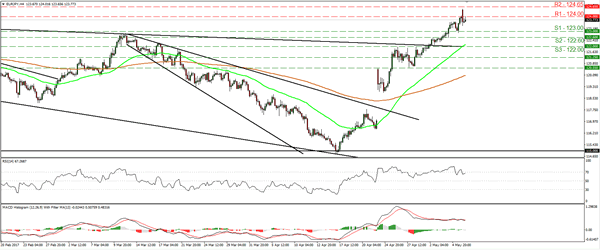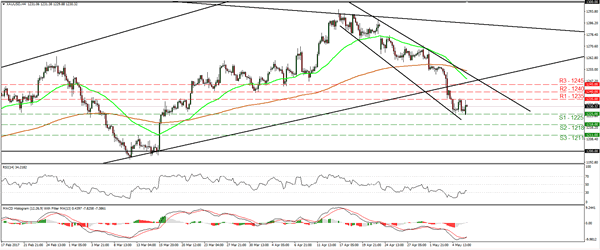Emmanuel Macron won the French Presidency by a wider-than-expected margin, beating Marine Le Pen by roughly 66% to 34%. The euro opened with a small positive gap against its major counterparts, but quickly gave back all its gains to trade even lower in the following hours. Considering that Macron’s victory was widely anticipated, we think that this may have been due to investors locking in profits on existing EUR/USD-long positions near the psychological zone of 1.1000.
EUR/JPY gapped up as well, but hit resistance slightly below the 124.65 (R2) barrier and then it retreated. The price structure on the 4-hour chart still suggests a short-term uptrend. However, taking a look at our short-term oscillators, we see the likelihood for the corrective setback to continue for a while, perhaps for another test near the 123.00 (S1) support level. The RSI exited its above-70 territory, while the MACD, although positive, lies below its trigger line and points somewhat down.
With political risks now out the way – at least until the German election in September – we believe that market participants are likely to turn their attention back to incoming economic data and ECB policy. In that respect, Eurozone’s latest CPI data showed that core inflation is at its highest level in 3 years, amplifying the case for the ECB to shift to a more upbeat tune soon. As such, we think the path of least resistance for the euro is to the upside. If EUR/JPY bulls manage to take advantage of a possible setback near 123.00 (S1), we would expect them to aim again for the 124.65 (R2) resistance. A decisive break above that obstacle could trigger extensions towards the 125.50 (R3) territory.
US jobs report: Soft wage growth weighs on the dollar
US nonfarm payrolls rose by 211k in April, data showed on Friday, more than the consensus of 185k. The unemployment rate unexpectedly declined, beating the forecast for an uptick. The only soft aspect of the report was wages. Average hourly earnings rose by +0.3% mom in line with the forecast, but last month’s print was revised somewhat lower to +0.1% mom, which dragged the yearly rate down as well. Thus, even though the knee-jerk reaction in the dollar was positive due to the above-expectations NFP, the currency quickly gave back its gains to trade even lower against most of its major counterparts.
Gold traded somewhat higher on Friday, but remained range bound between the 1225 (S1) and 1235 (R1) levels. As long as the yellow metal is trading below the downside line drawn from the peak of the 21st of April, the short-term trend remains negative in our opinion. On Wednesday, after the FOMC meeting, the metal fell below the upside support line taken from the low of the 15th of December, which enhances the case for further declines in the foreseeable future. Nevertheless, for now we see the likelihood for a corrective rebound before sellers decide to take the reins again. A clear move above 1235 (R1) could confirm the case and perhaps aim for the 1240 (R2) or 1245 (R3) resistance hurdles.
Despite the slowdown in wages, this report is still solid overall in our view. Therefore, these data are consistent with the Fed raising rates again soon, something supported by market pricing for a June hike, which rose further after these releases and now rests at 83%. Even though we think a June hike is a likely outcome too, we believe that 83% is overly optimistic at this point. The market is treating a June hike as more or less a done deal, with still 5 weeks to go until that gathering and loads of critical data coming out in the meantime.
Today’s highlights:
During the European day, the economic calendar is very light. The only noteworthy indicator we get is Germany’s factory orders for March.
We have only one speaker on the agenda: St. Louis Fed President James Bullard.
As for the rest of the week, on Tuesday, we have no major events or indicators on the agenda. On Wednesday, China’s PPI and CPI data for April are due out. On Thursday, the RBNZ will announce its rate decision in early Asian time. In the absence of a forecast, we see the case for the officials to take no action again. Later during the day, the Bank of England policy decision will be in focus. This will be a ‘Super Thursday’ meeting, meaning that besides the rate announcement and meeting minutes, we will also get the quarterly Inflation Report. On Friday, we get US retail sales and CPI data, both for April.
EUR/JPY

Support: 123.00 (S1), 122.60 (S2), 122.00 (S3)
Resistance: 124.00 (R1), 124.65 (R2), 125.50 (R3)
XAU/USD

Support: 1225 (S1), 1218 (S2), 1211 (S3)
Resistance: 1235 (R1), 1240 (R2), 1245 (R3)













